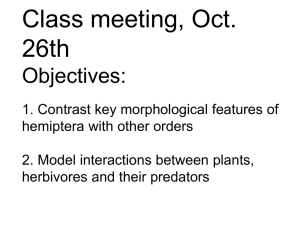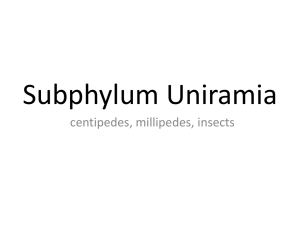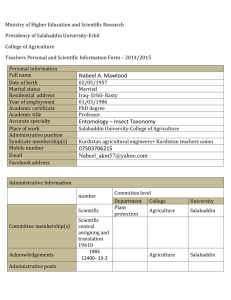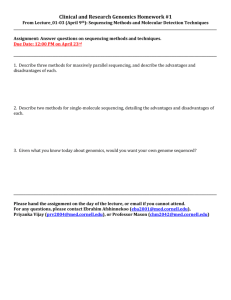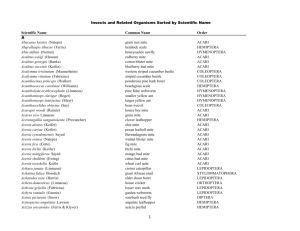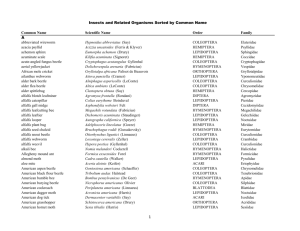Appendix S1. In silico simulation of taxonomic detection via Illumina
advertisement
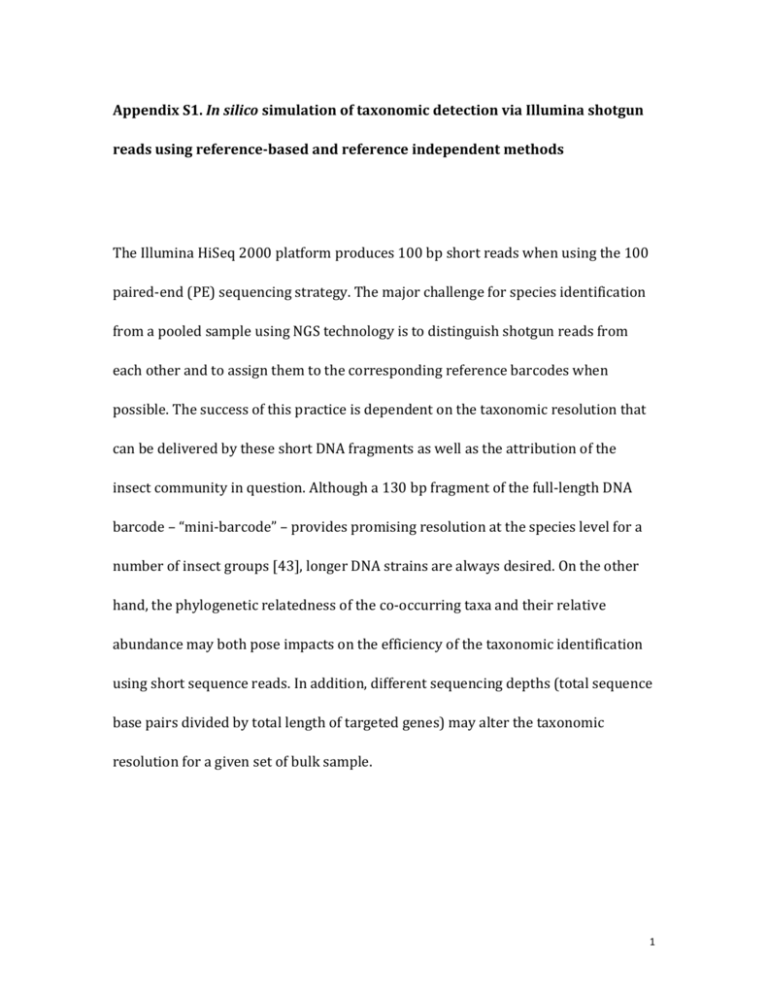
Appendix S1. In silico simulation of taxonomic detection via Illumina shotgun reads using reference-based and reference independent methods The Illumina HiSeq 2000 platform produces 100 bp short reads when using the 100 paired-end (PE) sequencing strategy. The major challenge for species identification from a pooled sample using NGS technology is to distinguish shotgun reads from each other and to assign them to the corresponding reference barcodes when possible. The success of this practice is dependent on the taxonomic resolution that can be delivered by these short DNA fragments as well as the attribution of the insect community in question. Although a 130 bp fragment of the full-length DNA barcode – “mini-barcode” – provides promising resolution at the species level for a number of insect groups [43], longer DNA strains are always desired. On the other hand, the phylogenetic relatedness of the co-occurring taxa and their relative abundance may both pose impacts on the efficiency of the taxonomic identification using short sequence reads. In addition, different sequencing depths (total sequence base pairs divided by total length of targeted genes) may alter the taxonomic resolution for a given set of bulk sample. 1 Material and Methods We propose solutions for two different scenarios (i.e., where a reference COI barcode library is available for the investigated fauna, and where it is not). The protocols and criteria of species identification employed by both methods have been explained in the Methods session in the main text. Briefly, when the reference library is present, Illumina shotgun reads can be aligned to the reference sequences at > 99% identity for the full PE reads. Only when > 90% length of a reference is matched by shotgun reads, this reference is considered detected in the bulk sample. Alternatively, if the reference library is unavailable, Illumina reads can be de novo assembled into contigs and scaffolds using SOAPdenovo [45,46]. COI barcode sequences are identified from these longer DNA fragments based on annotation and amino acid sequences. In real community samples, non-arthropod barcodes (microbes and other contaminates) can be eliminated by searching against the Barcode of Life Data Systems (BOLD) and GenBank. The final set of COI MOTUs can be further assigned to the lowest taxonomic identity through BOLD or used directly as a proxy of the species-level richness. To test the feasibility of these methods, we created six mock-up samples, each with species of varied relatedness and abundances, from 209 complete insect mitochondrial genomes obtained from the GenBank (Table S3). Although these taxa cannot represent real insect diversity in natural communities, this dataset contains 2 a good variety of insect lineages, including a few genera with closely related species, thus provides a good opportunity to examine the proposed methods. 1) Reference based method Reference barcode library In the simulation process, standardized COI barcode regions obtained from full mitochondrial genomes were used as reference sequences. These barcode sequences were identified by searching for conservative primer regions flanking the barcode region, using the Folmer primers (LCO1490 and HCO2198, Table S4) [30]. “Shotgun” reads Mitochondrial genomes in each mock-up mixture were randomly broken into 180bp fragments and were “sequenced” using a 100 bp PE sequencing strategy. One percent sequencing error rate was assigned to better simulate the real sequencing process [68]. Aligning method and matching criteria The program BLASTN was employed [60] to align short reads to reference barcode sequences (standardized COI barcodes obtained from whole mitochondrial genomes), allowing 99% identity and full length alignment of the PE reads. SOAP 3 coverage [61] was then used to calculate the overall coverage of reference barcodes (Figure S2 in additional file 3). A reference sequence was considered matched only when > 90% coverage was reached. Mock-up samples For the reference-based method, we created 3 sets of in silico simulations (Table S5): (1A) all 209 species were pooled at even abundance, which was sequenced at 100X sequencing depth to gain basic understanding of the performance of the proposed informatics protocol; (1B) 5 species that each had multiple closely related species presented in the reference were pooled at even abundances and sequenced at 100X; and (1C) the same species set from (1B) were sequenced at 1,000X depth to explore the influence of sequencing depth on taxonomic resolution. The full set of reference barcodes consisting of 209 species was made available for species identification for all 3 simulations. 2) Reference independent method De novo assembly and annotation In the reference independent method (Table S5), shotgun reads created in the same way described above were de novo assembled into longer DNA sequences (contigs 4 and scaffolds), using the program SOAPdenovo [45,46]. The barcode regions were then identified using the annotated amino acid sequences. Mock-up samples Three mock-up samples were created for the reference independent method: (2A) 15 mitochondrial genomes were pooled at varied abundances and were sequenced at 100X to test the efficiency of the assembly approach; (2B) 4 closely related Drosophila species were pooled at even abundances and were sequenced at 10X to understand the taxonomic resolution when a reference barcode library was absent; (2C) the same set of 4 Drosophila species at varied abundance. Results 1) Reference based method In simulation 1A, all 209 species mixed at even abundance were detected using our matching criteria. As expected, most species received average sequence coverage around 100X, but those with closely related taxa (congeneric species or subspecies) present in the reference exceeded this value: 2 subspecies of the butterfly Sasakia charonda and 4 closely related species from the fly genus Bactrocera. Because the sequence divergences between these closely related taxa were so small (≤ 0.5%), 5 the simulated shotgun sequences could not be unambiguously assigned to the corresponding reference barcodes, but were aligned to multiple templates. Simulations 1B and 1C represented a more realistic scenario where a range of taxonomic groups from the bulk sample were compared against a reference barcode library, which contained a number of closely related taxa (congeners) of the targeted species. As a result, all 5 taxa were correctly identified to a species level at 100X sequencing depth. Specifically, Illumina reads were able to distinguish Solenopsis richteri, Reticultitermes santonensis, Drosophila simulans, and Bactrocera papayae from the corresponding species of close phylogenetic relatedness, using our matching criteria (> 90% coverage). The latter 3 species all had congeners in the reference that possessed < 1% interspecific divergences in their full-length barcodes. Although short reads belonging to Sasakia charonda were matched to both of its subspecies (S. charonda and S. c. kuriyamaensis), the species-level identification was achieved. The coverage of Bactrocera papaya reads to B. philippinensis was very close to our threshold (87%), and could represent a difficult example if other parameters were changed (e.g., sequencing depth, presence of closely related species in the bulk sample, variation in abundance). The increased sequencing depth at 1,000X did not improve taxonomic resolution for the problematic taxa, specifically Bactrocera papaya. To the contrary, unambiguity in the reference-based identification method was elevated – shotgun reads 6 belonging to B. papaya were matched to both itself and B. philippinensis at 100% coverage, while coverages to B. dorsalis and B. carambolae were raised to 84% and 83%, respectively (compared to 74% and 54% at 100X sequencing depth, respectively). All the other 4 species were successfully identified at the species level at 1,000X (Figure S7 in Additional file 3). 2) Reference independent method The 15 species from simulation 2A contained 1 representative from each of the genera that had multiple species present in the reference. But no closely related species were included in this mock-up bulk sample. All 15 species were successfully de novo assembled into full-length barcodes. And all assemblies showed 100% identify to the corresponding reference sequence. Simulation 2B included 4 Drosophila species at even abundance, 3 of which had interspecific barcode divergences < 2% (D. mauritiana, D. sechellia, and D. simulans). This mock-up sample represented an informatics challenge to the assembly approach, although such community would be rare in natural conditions. At 10X sequencing depth, we were able to assemble COI barcodes for D. mauritiana (553 bp) and the fourth species D. melanogaster (658 bp). However, only partial COI 7 barcode (a maximum of 360 bp) was assembled for D. simulans due to its close relatedness to D. sechellia, whose assembly was not successful. When closely related species co-occurred in the bulk sample, the de novo assembly approach seemed to favor those with higher abundance. For example, in simulation 2C, the assembling processes for both abundant species (D. mauritiana and D. simulans) produced COI fragments of 553 bp, while that for the 2 species with lower abundance had failed. Conclusions 1. Taxonomic resolution is largely dependent on that of the full-length barcodes and is not limited by the length of Illumina shotgun reads or informatics. 2. The availability of a reference DNA barcode library will facilitate taxonomic identification at the species level. But taxon richness analysis can still be achieved without the reference library by using MOTUs as proxies, which can be de novo assembled and annotated from Illumina reads. 3. Both the reference-based and reference independent methods can reveal species richness information in high fidelity. But co-occurring taxa of extremely close relatedness (e.g., interspecific divergence < 1%) are difficult 8 to distinguish, which can be further complicated when the relevant species show significantly different abundances. References 68. Hu X, Yuan J, Shi Y, Lu J, Liu B, Li Z, Chen Y, Mu D, Zhang H, Li N: pIRS: Profilebased Illumina pair-end reads simulator. Bioinformatics 2012, 28:1533–1535. 9 Supplementary Tables Table S3 Taxonomic, abundance, and sequencing information of simulation 1A (reference-based) GI number Order Family Species 218157371 Archaeognatha Machilidae Pedetontus silvestrii 171473585 Archaeognatha Machilidae Trigoniophthalmus alternatus 62161388 Archaeognatha Meinertellidae Nesomachilis australica 242624230 Blattaria Blattellidae Blattella germanica 50812103 Blattaria Blattidae Periplaneta fuliginosa 299827802 Blattaria Polyphagidae Eupolyphaga sinensis 224587990 Coleoptera Aspidytidae Aspidytes niobe 270267691 Coleoptera Bostrichidae Apatides fortis 270267663 Coleoptera Buprestidae Acmaeodera sp. NCS-2009 238866876 Coleoptera Buprestidae Chrysochroa fulgidissima 270267607 Coleoptera Cantharidae Chauliognathus opacus 10 255506410 Coleoptera Cerambycidae Psacothea hilaris 18390112 Coleoptera Chrysomelidae Crioceris duodecimpunctata 159159429 Coleoptera Elateridae Pyrophorus divergens 258649546 Coleoptera Gyrinidae Macrogyrus oblongus 21326209 Coleoptera Lampyridae Pyrocoelia rufa 270267635 Coleoptera Lucanidae Lucanus mazama 208433946 Coleoptera Melyridae Chaetosoma scaritides 258649600 Coleoptera Mordellidae Mordella atrata 208433960 Coleoptera Ommatidae Tetraphalerus bruchi 190349565 Coleoptera Phengodidae Rhagophthalmus lufengensis 192293811 Coleoptera Phengodidae Rhagophthalmus ohbai 258650138 Coleoptera Scarabaeidae Rhopaea magnicornis 208433918 Coleoptera Scirtidae Cyphon sp. BT0012 270267294 Coleoptera Tenebrionidae Adelium sp. NCS-2009 133755325 Coleoptera Tenebrionidae Tribolium castaneum 11 208433759 Coleoptera Trachypachidae Trachypachus holmbergi 13435200 Diptera Calliphoridae Chrysomya putoria 12711796 Diptera Calliphoridae Cochliomyia hominivorax 154800398 Diptera Calliphoridae Lucilia sericata 255506277 Diptera Cecidomyiidae Mayetiola destructor 255506236 Diptera Cecidomyiidae Rhopalomyia pomum 157326160 Diptera Ceratopogonidae Culicoides arakawae 164523399 Diptera Culicidae Aedes aegypti 58372083 Diptera Culicidae Aedes albopictus 299828908 Diptera Culicidae Anopheles darlingi 5834911 Diptera Culicidae Anopheles gambiae 5835918 Diptera Culicidae Anopheles quadrimaculatus A 308745776 Diptera Culicidae Culex quinquefasciatus 215259920 Diptera Drosophilidae Drosophila littoralis 45332696 Diptera Drosophilidae Drosophila mauritiana 12 5835233 Diptera Drosophilidae Drosophila melanogaster 45332682 Diptera Drosophilidae Drosophila sechellia 45332829 Diptera Drosophilidae Drosophila simulans 5834829 Diptera Drosophilidae Drosophila yakuba 67009990 Diptera Muscidae Haematobia irritans 120944055 Diptera Nemestrinidae Trichophthalma punctata 54306052 Diptera Oestridae Dermatobia hominis 290967645 Diptera Oestridae Hypoderma lineatum 120944038 Diptera Syrphidae Simosyrphus grandicornis 120944077 Diptera Tabanidae Cydistomyia duplonotata 312233479 Diptera Tachinidae Exorista sorbillans 156765981 Diptera Tephritidae Bactrocera carambolae 120586710 Diptera Tephritidae Bactrocera dorsalis 302632666 Diptera Tephritidae Bactrocera minax 41057423 Diptera Tephritidae Bactrocera oleae 13 156765967 Diptera Tephritidae Bactrocera papayae 156765995 Diptera Tephritidae Bactrocera philippinensis 309259980 Diptera Tephritidae Bactrocera tryoni 5835876 Diptera Tephritidae Ceratitis capitata 229324789 Ephemeroptera Ephemeridae Ephemera orientalis 209427686 Ephemeroptera Heptageniidae Parafronurus youi 288903297 Ephemeroptera Siphlonuridae Siphlonurus immanis 51830142 Hemiptera Aleyrodidae Aleurochiton aceris 49146478 Hemiptera Aleyrodidae Aleurodicus dugesii 52220940 Hemiptera Aleyrodidae Bemisia tabaci 51830183 Hemiptera Aleyrodidae Neomaskellia andropogonis 52221066 Hemiptera Aleyrodidae Tetraleurodes acaciae 52220968 Hemiptera Aleyrodidae Trialeurodes vaporariorum 225697513 Hemiptera Alydidae Riptortus pedestris 225676739 Hemiptera Anthocoridae Orius niger 14 213948225 Hemiptera Aphididae Acyrthosiphon pisum 51830049 Hemiptera Aphididae Schizaphis graminum 49146630 Hemiptera Aphrophoridae Philaenus spumarius 225697511 Hemiptera Aradidae Neuroctenus parus 225697515 Hemiptera Berytidae Yemmalysus parallelus 62161309 Hemiptera Cicadellidae Homalodisca vitripennis 225697512 Hemiptera Colobathristidae Phaenacantha marcida 225697508 Hemiptera Coreidae Hydaropsis longirostris 225697509 Hemiptera Cydnidae Macroscytus subaeneus 283099275 Hemiptera Delphacidae Laodelphax striatellus 228015376 Hemiptera Flatidae Geisha distinctissima 240266556 Hemiptera Fulgoridae Lycorma delicatula 240266730 Hemiptera Gelastocoridae Nerthra sp. NKMT022 240266626 Hemiptera Gerridae Gerris sp. NKMT033 240266640 Hemiptera Hydrometridae Hydrometra sp. NKMT020 15 299829047 Hemiptera Issidae Sivaloka damnosus 225676740 Hemiptera Largidae Physopelta gutta 225676457 Hemiptera Lygaeidae Geocoris pallidipennis 225697510 Hemiptera Malcidae Malcus inconspicuus 240266682 Hemiptera Naucoridae Ilyocoris cimicoides 240266354 Hemiptera Nepidae Laccotrephes robustus 240266368 Hemiptera Notonectidae Enithares tibialis 240266382 Hemiptera Ochteridae Ochterus marginatus 260150943 Hemiptera Pentatomidae Halyomorpha halys 218456815 Hemiptera Pentatomidae Nezara viridula 225697506 Hemiptera Plataspidae Coptosoma bifaria 240266410 Hemiptera Pleidae Paraplea frontalis 225660332 Hemiptera Pyrrhocoridae Dysdercus cingulatus 11182462 Hemiptera Reduviidae Triatoma dimidiata 240266424 Hemiptera Reduviidae Valentia hoffmanni 16 225697457 Hemiptera Rhopalidae Aeschyntelus notatus 299829158 Hymenoptera Apidae Apis cerana 5834925 Hymenoptera Apidae Apis mellifera 221143400 Hymenoptera Apidae Bombus hypocrita 190349384 Hymenoptera Apidae Bombus ignitus 27733916 Hymenoptera Apidae Melipona bicolor 299827774 Hymenoptera Braconidae Cotesia vestalis 299828950 Hymenoptera Braconidae Spathius agrili 237515443 Hymenoptera Cephidae Cephus cinctus 258649392 Hymenoptera Evaniidae Evania appendigaster 312233080 Hymenoptera Formicidae Solenopsis geminata 312233122 Hymenoptera Formicidae Solenopsis invicta 312233150 Hymenoptera Formicidae Solenopsis richteri 237869070 Hymenoptera Ichneumonidae Diadegma semiclausum 306960063 Hymenoptera Mutillidae Radoszkowskius oculata 17 237515457 Hymenoptera Orussidae Orussus occidentalis 211908570 Hymenoptera Vespidae Abispa ephippium 148368751 Isoptera Rhinotermitidae Reticulitermes flavipes 148368779 Isoptera Rhinotermitidae Reticulitermes hageni 148368807 Isoptera Rhinotermitidae Reticulitermes santonensis 148368765 Isoptera Rhinotermitidae Reticulitermes virginicus 295065650 Lepidoptera Arctiidae Hyphantria cunea 18644896 Lepidoptera Bombycidae Bombyx mandarina 8572562 Lepidoptera Bombycidae Bombyx mori 260150957 Lepidoptera Crambidae Diatraea saccharalis 18314290 Lepidoptera Crambidae Ostrinia nubilalis 170787328 Lepidoptera Geometridae Phthonandria atrilineata 94490710 Lepidoptera Lycaenidae Coreana raphaelis 242610072 Lepidoptera Lymantriidae Lymantria dispar 312233066 Lepidoptera Noctuidae Helicoverpa armigera 18 195954010 Lepidoptera Notodontidae Ochrogaster lunifer 280978083 Lepidoptera Nymphalidae Acraea issoria 308745928 Lepidoptera Nymphalidae Hipparchia autonoe 297572359 Lepidoptera Nymphalidae Sasakia charonda 297572345 Lepidoptera Nymphalidae Sasakia charonda 295065636 Lepidoptera Papilionidae Papilio maraho 295065608 Lepidoptera Papilionidae Parnassius bremeri 302632610 Lepidoptera Papilionidae Teinopalpus aureus 177807247 Lepidoptera Pieridae Artogeia melete 162279939 Lepidoptera Saturniidae Antheraea pernyi 238694149 Lepidoptera Saturniidae Antheraea yamamai 238563960 Lepidoptera Saturniidae Eriogyna pyretorum 184202694 Lepidoptera Saturniidae Saturnia boisduvalii 165932395 Lepidoptera Sphingidae Manduca sexta 299829144 Lepidoptera Tortricidae Spilonota lechriaspis 19 84488776 Mantodea Mantidae Tamolanica tamolana 84488734 Mantophasmatodea Mantophasmatidae Sclerophasma paresisense 256985280 Mecoptera Panorpidae Neopanorpa pulchra 205351318 Megaloptera Corydalidae Corydalus cornutus 211998787 Megaloptera Corydalidae Protohermes concolorus 258649614 Megaloptera Sialidae Sialis hamata 205351332 Neuroptera Ascalaphidae Ascaloptynx appendiculatus 258649628 Neuroptera Mantispidae Ditaxis biseriata 205351290 Neuroptera Polystoechotidae Polystoechotes punctatus 306960177 Odonata Euphaeidae Euphaea formosa 229317937 Odonata Gomphidae Davidius lunatus 207268051 Orthoptera Acrididae Acrida willemsei 288900664 Orthoptera Acrididae Arcyptera coreana 207269079 Orthoptera Acrididae Calliptamus italicus 194871823 Orthoptera Acrididae Chorthippus chinensis 20 304322824 Orthoptera Acrididae Euchorthippus fusigeniculatus 195661170 Orthoptera Acrididae Gastrimargus marmoratus 301353420 Orthoptera Acrididae Gomphocerippus rufus 288904176 Orthoptera Acrididae Gomphocerus licenti 195933665 Orthoptera Acrididae Locusta migratoria 5835247 Orthoptera Acrididae Locusta migratoria 195661156 Orthoptera Acrididae Oedaleus decorus 283098215 Orthoptera Acrididae Ognevia longipennis 164420921 Orthoptera Acrididae Oxya chinensis 219524285 Orthoptera Acrididae Phlaeoba albonema 288903464 Orthoptera Acrididae Prumna arctica 258649420 Orthoptera Acrididae Schistocerca gregaria 288903338 Orthoptera Acrididae Traulia szetschuanensis 207268065 Orthoptera Gryllidae Myrmecophilus manni 219524229 Orthoptera Gryllidae Teleogryllus emma 21 58045502 Orthoptera Gryllotalpidae Gryllotalpa orientalis 207269746 Orthoptera Gryllotalpidae Gryllotalpa pluvialis 309259966 Orthoptera Pamphagidae Thrinchus schrenkii 306960149 Orthoptera Pneumoridae Physemacris variolosa 219524243 Orthoptera Pyrgomorphidae Atractomorpha sinensis 304322838 Orthoptera Pyrgomorphidae Mekongiana xiangchengensis 304322852 Orthoptera Pyrgomorphidae Mekongiella xizangensis 207270760 Orthoptera Rhaphidophoridae Troglophilus neglectus 306960135 Orthoptera Romaleidae Xyleus modestus 159524429 Orthoptera Tettigoniidae Anabrus simplex 219524090 Orthoptera Tettigoniidae Deracantha onos 299829075 Orthoptera Tettigoniidae Elimaea cheni 197935811 Orthoptera Tettigoniidae Gampsocleis gratiosa 157786563 Orthoptera Tettigoniidae Ruspolia dubia 306960090 Orthoptera Tridactylidae Ellipes minuta 22 312233136 Phasmatodea Diapheromeridae Micadina phluctainoides 312233193 Phasmatodea Heteropterygidae Heteropteryx dilatata 313247873 Phasmatodea Phasmatidae Entoria okinawaensis 312233307 Phasmatodea Phasmatidae Megacrania alpheus 312233164 Phasmatodea Phasmatidae Phobaeticus serratipes 313199763 Phasmatodea Phasmatidae Phraortes illepidus 312233493 Phasmatodea Phasmatidae Phraortes sp. Iriomote Island 256985350 Phasmatodea Phasmatidae Ramulus hainanense 12383036 Phthiraptera Boopidae Heterodoxus macropus 160425216 Phthiraptera Philopteridae Bothriometopus macrocnemis 89257204 Phthiraptera Philopteridae Campanulotes bidentatus 51101192 Plecoptera Pteronarcyidae Pteronarcys princeps 31324905 Psocoptera Lepidopsocidae Lepidopsocidae sp. RS-2001 258649574 Raphidioptera Raphidiidae Mongoloraphidia harmandi 25057389 Thysanoptera Thripidae Thrips imaginis 197935825 Thysanura Nicoletiidae Atelura formicaria 23 42632243 Thysanura Lepidotrichidae Tricholepidion gertschi 50812159 Thysanura Lepismatidae Thermobia domestica A set of 209 complete insect mitochondrial genomes was obtained from the GenBank. All MT genomes were used in simulation 1A, where all species were given even abundance and were sequenced at 100X. 24 Table S4 Primer set used to pick out reference barcode region Primer Sequence (5’ to 3’) LCO1490A-F TCTCTACCAACCACAAAGACATTGG HCO2198A-R TAAACTTCNGGGTGNCCAAAGAATCA 25 Table S5 Different simulation strategies of in silico analysis Method Reference based Reference independent Simulation 1A 1B 1C 2A 2B 2C Number of species 209 5 5 15 4 4 Taxonomic, abundance Table Table Table Table Table Table & S3 S6 S7 S8 S9 S10 209 5 6 15 3 2 sequencing information Discovered species (MOTUs) 26 Table S6 Taxonomic, abundance, and sequencing information of simulation 1B (reference-based) Taxon Abundance Sequencing depth (X) Solenopsis richteri 1 100 Reticulitermes santonensis 1 100 Sasakia charonda 1 100 Drosophila simulans 1 100 Bactrocera papaya 1 100 27 Table S7 Taxonomic, abundance, and sequencing information of simulation 1C (reference-based) Abundance Sequencing depth Taxon (X) Solenopsis richteri 1 1000 Reticulitermes santonensis 1 1000 Sasakia charonda 1 1000 Drosophila simulans 1 1000 Bactrocera papaya 1 1000 28 Table S8 Taxonomic, abundance, and sequencing information of simulation 2A (reference independent) Taxon Abundance Sequencing depth (X) Reticulitermes santonensis 5 100 Bombyx mandarina 20 100 Bombus ignites 8 100 Rhagophthalmus lufengensis 1 100 Locusta migratoriamigratoria 2 100 Antheraea yamamai 5 100 Sasakia charonda 3 100 Anopheles darlingi 5 100 Apis cerana 5 100 Bactrocera tryoni 5 100 Solenopsis richteri 17 100 Phraortes sp. Iriomote Island 2 100 Gryllotalpa orientalis 7 100 Drosophila melanogaster 12 100 Aedes albopictus 16 100 29 Table S9 Taxonomic, abundance, and sequencing information of simulation 2B (reference independent) Taxon Abundance even Sequencing depth (X) Drosophila melanogaster 1 10 Drosophila sechellia 1 10 Drosophila simulans 1 10 Drosophila mauritiana 1 10 30 Table S10 Taxonomic, abundance, and sequencing information of simulation 2C (reference independent) Taxon Abundance uneven Sequencing depth (X) Drosophila melanogaster 1 10 Drosophila sechellia 1 10 Drosophila simulans 10 10 Drosophila mauritiana 10 10 31
